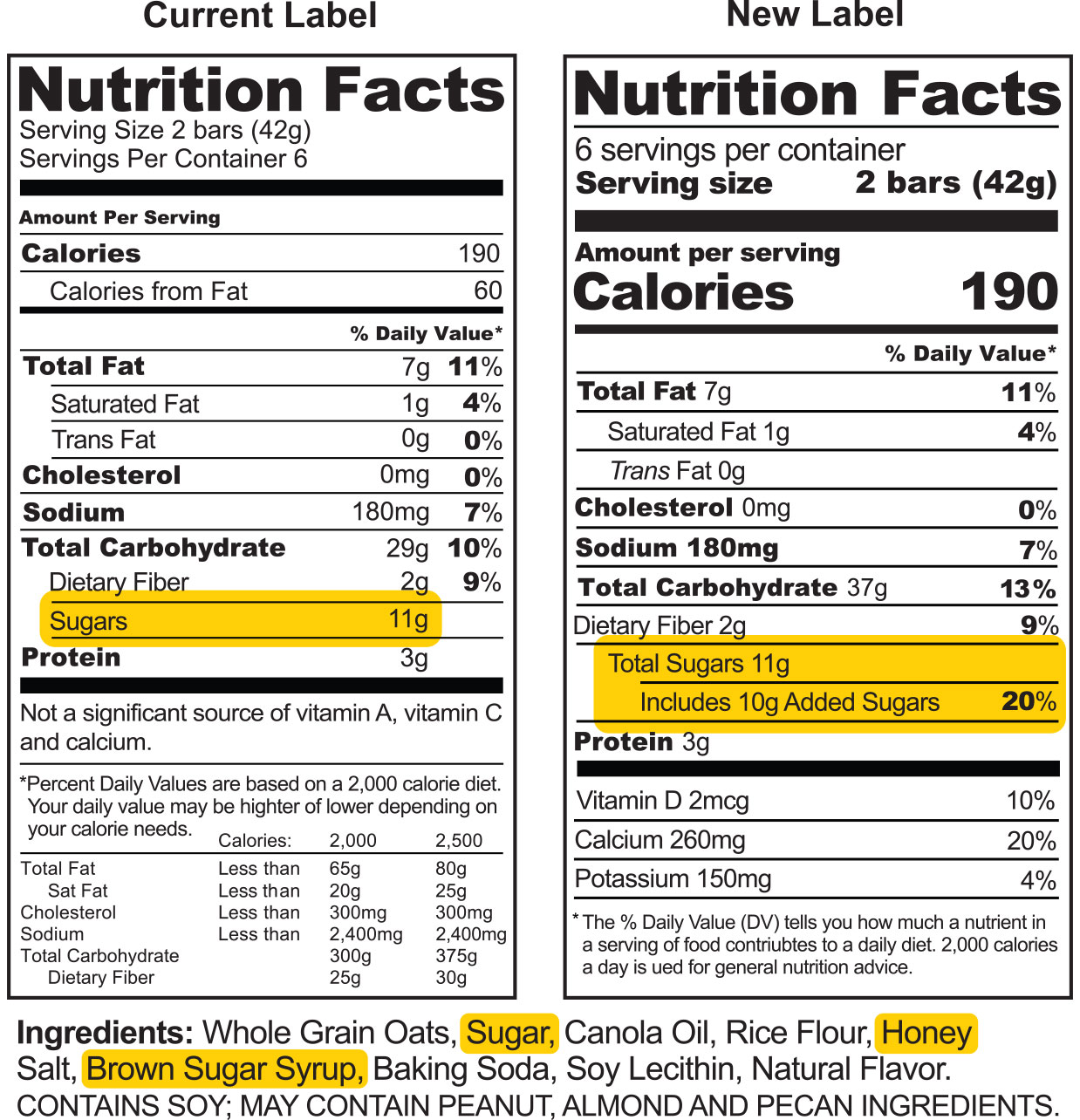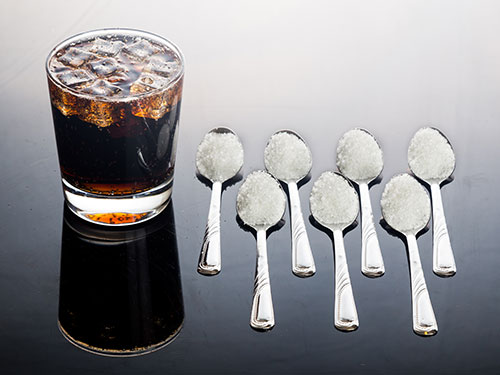
Fact Sheet FS1305
Many Americans consume much more sugar than is considered healthy. In fact, consumption of added sugars has steadily risen in the past few decades, and currently, studies indicate that the average American eats 22 teaspoons of added sugar per day, which is about 3 times more than the recommended amount.
Our bodies do need some sugar in order to function properly. For example, sugar, which our bodies convert to glucose, provides the sole source of energy for red blood cells and for the brain. However, when it comes to sugar, it can be very easy to consume too much of a good thing.
Naturally Occurring Sugars vs. Added Sugars
Some sugars occur naturally in fruits, vegetables, dairy products, and some grains. Eating these foods, as part of a complete, balanced diet, can provide enough sugar for our needs. Our bodies do not need any amount of added sugars to function properly or stay healthy.
Added sugars are those that are put into foods during processing or preparation, or that are added before eating; for example, using sugar to sweeten coffee. The term "added sugars" refers to more than just white sugar, which is what may come to mind when many people hear the word "sugar." There are many other forms of sugar that are commonly added to foods. See Sugar Aliases for a list of the names of sugars that may be found on a food's ingredient list.
In general, foods that contain naturally-occurring sugars are not a big concern for healthy people. In addition to containing sugars, these foods are also nutrient-dense, meaning that they tend to be high in nutrients that our bodies need. However, foods with added sugars have been on the rise in the American diet for several years, which is concerning because of the effects that excess sugar can have on our health.
How Does Excess Sugar Affect Health?
Consumption of added sugars can increase the number of calories a person consumes, without any added nutritional benefit, making it difficult to meet nutrient needs while staying within calorie limits. However, foods that contain naturally-occurring sugars also contribute beneficial nutrients to the diet, such as vitamins, calcium, and fiber.
Too much added sugar in the diet can contribute to weight gain. Research also shows that there is a strong link between excess added sugar in the diet and conditions such as diabetes, fatty liver disease, and heart disease.
Added sugars are also a major contributor to dental caries (cavities).
Where Can I Find Added Sugars?
Currently, the number one source of added sugars in the American diet is beverages. Those that contain added sugars include:
Added sugars are also found in many other foods, some of which may come as a surprise because they tend to not be considered sweet. These include (but are not limited to):

Figure 1.
Pay particular attention to products labeled "low-fat" or "fat-free," as they often contain added sugar to make up for taste and texture that is lost when fat is removed.
Finding added sugars in foods requires a little investigation. The only way to know for sure if a food contains added sugars is to read the food's Nutrition Facts label. The current Nutrition Facts label lists the total amount of sugar in a food, a number that lumps together both naturally-occurring and added sugars. To find out if there are added sugars included in this number, check the ingredient list (found on the back of the package, beneath the Nutrition Facts label) for sugar or one of sugar's many "aliases" (see Sugar Aliases). This will tell you if there is added sugar in the food; however, it will not tell you how much of the total grams of sugar is added vs. the amount that is naturally-occurring.
The new Nutrition Facts label, which will soon be required to appear on many foods, will have a separate line for added sugars, making it easy to know how much of the sugar in a food is naturally-occurring, and how much was added during processing.
Sugar is listed on the Nutrition Facts label in grams per serving. Because a gram may not be a familiar measure to many people, it may be easier to think of sugar in teaspoons. A good rule of thumb when trying to determine how many teaspoons are in a food is to divide the number of grams by four (4) because:
4 grams of sugar = 1 teaspoon
For example, if the Nutrition Facts label for a particular food lists 12 grams of sugar, that means that there are 3 teaspoons of sugar in one serving of that food (12 ÷ 4 = 3).

Figure 2.
Why Is Sugar Added to So Many Foods?
Sugar sweetens food, making it more attractive to our taste buds. Humans have a natural preference for sweetness, so food producers tend to add sugars to various foods to make them more appealing to consumers.
Other reasons for adding sugar include preserving foods and maintaining and/or improving texture, color, and other functional characteristics.
How Much Sugar Should I Eat?
The amount of added sugar the average American eats on a daily basis (22 teaspoons) stands in sharp contrast to the recommendation from the American Heart Association that women and children should eat no more than 6 teaspoons (24 grams) of added sugars per day, and men eat no more than 9 teaspoons (36 grams) per day.
For reference, there are more than 16 teaspoons (65 grams) of added sugars in one 20-ounce bottle of soda/pop.
How Can I Find Added Sugar?
When reading a food's ingredient list, it may not be easy to know if there is added sugar in that food because sugar can be described by several other names, depending on its source and how it was produced. One clue to finding sugars in an ingredient list is to look for words ending in "-ose," such as dextrose or fructose – all of these are some type of sugar.
One common misconception is that some types of sugars – for example, honey, coconut sugar, fruit juice concentrates, or raw sugar – are more nutritious than others. However, there is no nutritional advantage to these types of sugars over traditional white, granulated sugar.
Other sweeteners that contain low or no calories, and are not considered to be added sugars, include stevia, saccharin, aspartame, sucralose, and sugar alcohols, and are found in products such as Splenda®, Equal®, Truvia®, Sweet'N Low®, and xylitol, among others. These high-intensity sweeteners are commonly found in highly processed foods, such as soft drinks, baked goods, and candy. These foods generally do not offer the same nutritional benefits as whole foods, such as fruits and vegetables.
Sugar Aliases
Sugar has many aliases on foods' ingredient lists, including, but not limited to, the following:
Tips to Avoid Added Sugars
In summary: our bodies can get all the sugar they need from foods with naturally-occurring sugars. Knowing how and where to find added sugars, and how to avoid them, can help to keep their intake to a minimum. Practice reading labels and incorporate the tips above to ensure that your added sugar intake stays within recommended limits for a healthy diet.
For more information on added sugars, visit:
Mention or display of a trademark, proprietary product, or firm in text or figures does not constitute an endorsement by Rutgers Cooperative Extension and does not imply approval to the exclusion of other suitable products or firms.
Photo credits: iStockphoto.
June 2019
Copyright © 2024 Rutgers, The State University of New Jersey. All rights reserved.
For more information: njaes.rutgers.edu.
Cooperating Agencies: Rutgers, The State University of New Jersey, U.S. Department of Agriculture, and Boards of County Commissioners. Rutgers Cooperative Extension, a unit of the Rutgers New Jersey Agricultural Experiment Station, is an equal opportunity program provider and employer.



